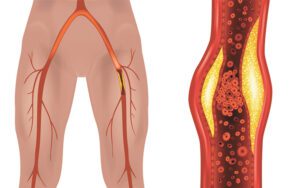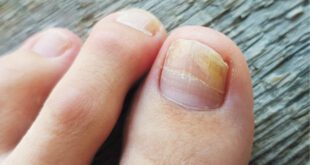By Dr. Andrew Franklin, DPM, PH.D
 September marks Peripheral Arterial Disease (PAD) Awareness Month, making it an ideal opportunity to discuss this often-overlooked vascular condition. As a foot and ankle specialist, I frequently encounter patients whose first symptoms of PAD manifest in their feet, yet many remain unaware of the serious implications this disease can have on their overall health.
September marks Peripheral Arterial Disease (PAD) Awareness Month, making it an ideal opportunity to discuss this often-overlooked vascular condition. As a foot and ankle specialist, I frequently encounter patients whose first symptoms of PAD manifest in their feet, yet many remain unaware of the serious implications this disease can have on their overall health.
Understanding PAD:
More Than Poor Circulation
Peripheral Arterial Disease develops when plaque accumulates within the arteries supplying blood to your extremities, causing these vessels to narrow or become completely blocked. This arterial narrowing significantly reduces blood flow to your legs and feet, creating a cascade of potential health complications that extend far beyond simple circulation problems.
The condition represents a systemic issue that can signal increased risk for cardiovascular events, including heart attacks and strokes. In severe cases, insufficient blood flow can lead to tissue death and the need for amputation.
Recognizing the Warning Signs
Your lower extremities often serve as early indicators of PAD, displaying symptoms that shouldn’t be ignored:
Pain and Discomfort
. Cramping, aching, or fatigue in leg muscles during activity that subsides with rest (intermittent claudication)
. Persistent pain in feet or toes, particularly at night that is relieved with walking or dangling your feet off the bed.
Physical Changes
. Noticeable temperature differences between each legs
. Wounds or ulcers that heal slowly or not at all
. Changes in skin texture, including a shiny appearance
. Altered nail growth patterns
. Color changes in the skin of your legs or feet
Functional Limitations
. Weakness in the legs
. Reduced sensation in the feet
Risk Factors to Consider
Several factors can predispose individuals to developing PAD:
Age and Lifestyle
. Being over 50 years of age
. Current or former smoking habit
. Sedentary lifestyle
Medical Conditions
. Diabetes mellitus
. Hypertension
. Elevated cholesterol levels
. Obesity
Genetic Predisposition
. Family history of cardiovascular disease
. Personal history of heart disease or stroke
Prevention and Management Strategies
Taking proactive steps can significantly reduce your PAD risk and improve outcomes if you already have the condition:
Medical Monitoring
Regular vascular screenings, particularly for those over 50 or with risk factors, allow for early detection. Simple, painless tests can evaluate blood flow and identify potential problems before they become severe.
Lifestyle Modifications
. Tobacco Cessation: Eliminating tobacco use is perhaps the most impactful change you can make for vascular health
. Exercise Program: Structured walking programs and regular physical activity improve circulation and can alleviate symptoms
. Chronic Disease Management: Maintaining optimal control of diabetes, blood pressure, and cholesterol levels through medication and lifestyle changes
Foot Care Protocols
. Daily inspection of feet for any abnormalities
. Proper hygiene and moisturization
. Immediate attention to any wounds or concerning changes
. Regular professional foot examinations
Taking Action This September
PAD Awareness Month serves as a reminder to prioritize your vascular health. If you’re experiencing any concerning symptoms or have multiple risk factors, don’t delay in seeking professional evaluation. Early intervention can prevent serious complications and preserve both your mobility and overall health.
Consider scheduling a comprehensive vascular assessment to establish baseline measurements and discuss personalized prevention strategies. Together, we can develop an approach that addresses your individual risk factors and helps maintain the health of your lower extremities for years to come.
The key to managing PAD lies in awareness, early detection, and consistent follow-through with treatment recommendations. Your feet often tell the story of your vascular health—let’s make sure it’s a positive one.
About Dr. Andrew Franklin, DPM, Ph.D
Dr. Andrew Franklin, DPM, Ph.D., moved from Essex, UK to the US in 2007, completing his post-doctorate in Organic Chemistry at FSU. He studied Podiatric Medicine at Ohio College of Podiatric Medicine and completed surgical residency at Cleveland Clinic. Relocating to Ocala in 2018, he opened Ocala Podiatry in December 2023. This board-certified podiatrist emphasizes patient education and teamwork. Married with two boys, he enjoys pickleball, sports, traveling, and outdoor activities.
(352) 234-4124
ocalapodiatry.com
5481 Southwest 60th St Unit 502,
Ocala, FL 34474
 Central Florida Health and Wellness Magazine Health and Wellness Articles of the Villages
Central Florida Health and Wellness Magazine Health and Wellness Articles of the Villages



